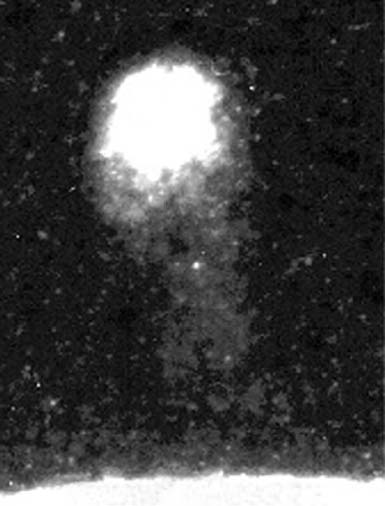Read Ancient Aliens on the Moon Online
Authors: Mike Bara
Ancient Aliens on the Moon (7 page)
Encouraged, Hoagland began by ordering pictures from some of NASA’s early 1960’s robotic probes sent to the Moon, especially the Lunar Orbiter series of spacecraft. He quickly found evidence of something far stranger than simply rocks or mountains.
The first photograph from this probe that Hoagland was able to acquire and examine (LO-III-84M) immediately revealed a number of striking, if bizarre objects on the photos. As he was scanning the horizon of LO-III-84M, he noticed something odd. There, sticking straight up more than a mile high out of the lunar surface, was something that absolutely did not belong; The “Shard.”
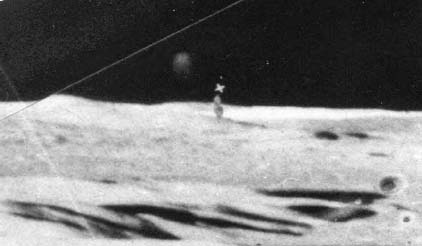
Wide angle view of the Shard, sticking 1.5 miles above the lunar surface. Bright smudge beyond is The Tower, a similar structure more than 7 miles high. “X” shaped object is a frame alignment registration mark. Note the shadow being cast across the lunar surface by the Shard, proving it is not a photographic defect or enhancement artifact.
On a bashed and battered lunar surface, exposed to billions of years of unshielded asteroid and meteorite bombardment, the Shard was a highly unusual, defiantly upright bowling-pin shaped structure, with an irregularly-pointed apex, a swollen middle “node” and a narrowing “foot.” Simply put, after billions of years of meteoric bombardment, an object like the Shard simply
can’t
exist anywhere on the surface of the Moon. Just like the Blair Cuspids, the very existence of its long shadow could serve as proof of its artificiality. With no atmosphere to protect such a structure from the constant onslaught of meteors, it should have been ground to dust eons before, even if it was some sort of exotic natural structure. Its very existence there on the Lunar Orbiter photo is in of itself proof of its artificial nature.
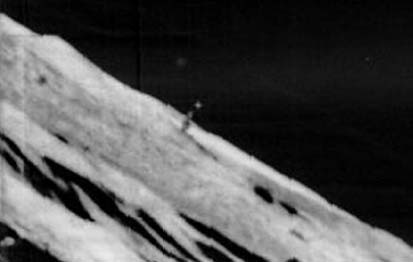
A closer look at the photo shows that it is not some sort of photographic defect, either. The readily-apparent shadow it was casting across the lunar surface is consistent with the local geography on which the Shard was sitting. In addition, the shadow was also consistent with the time of the month, the Lunar Orbiter camera angle, and the actual sun-angle illuminating the object when the image was initially acquired in mid-February 1967. It was this shadow, more than any other single aspect of this object, which solidified the Shard’s reality as an extremely anomalous, potentially manufactured lunar structure.
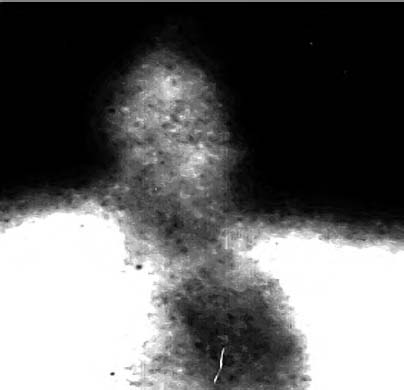
Close-up of the Shard showing semi-transparent internal structure.
There were other, crucial clues that the Shard was, in fact, a real object–still standing upright against gravity on the lunar surface. One was its alignment with the local vertical rather than with the grain of the Lunar Orbiter film; the second, was a highly geometric internal organization. But what was it made of? The whole thing seemed to shimmer in the light like some impossible Crystal Tower of the Moon.
The striking geometric pattern was composed of a repeating, complex, internal crystalline geometry, visible all throughout the object. Additional enhancements revealed this regular, internal pattern was made up of highly reflective and possibly hexagonal geometric compartments, greatly damaged but still visible. The overall impression one was left with was that of a once-much-larger, complex, crystalline, artificial object now extremely eroded by eons of meteorite impact processes.
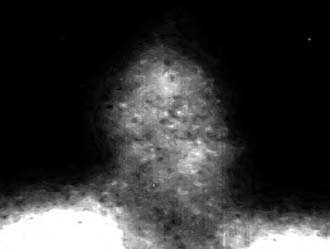
Ultra close-up of the top of the Shard.
Since it is virtually impossible to argue with the shadow cast by the Shard, and since the object’s very existence (therefore established) argues forcefully for its artificiality, some critics have looked to alternate explanations for its presence on LO-III-84M. It has been suggested, for instance, that the Shard may be a transient out-gassing event, luckily captured by the Lunar Orbiter camera. But, the absence of any diffusion or spray around the Shard’s sharply defined edges and all that obvious internal geometry works heavily against this explanation.
But there was an even more compelling argument favoring the Shard’s reality, to be made right from the same LO-III-84M frame: the striking presence of “the Tower”…
Just to the left of the Shard in the Lunar Orbiter frame LO-III-84M lies what at first appeared to be a faint smudge on the image. However, on close inspection and under additional enhancement, it quickly became obvious that this is a second glass-like anomaly in the same frame. Christened “The Tower” by Hoagland because of its immense size compared to the Shard, the Tower appears to be rising from a point over the horizon, making it at least 260 miles from the camera and more than 7 miles high! Like the Shard, it is aligned with the local vertical rather than the camera or the film grain, and there are even hints of guy-wire like filaments holding the immense structure up.
But could there be another explanation? Maybe it was a comet, or a star or even a far distant nebula or galaxy? The comet idea was quickly discarded when a quick check found no comets of any significance passing through the solar system in February, 1967. As to the possibility of it being a star, nebula or distant galaxy, those possibilities were also put to rest rather easily.
NASA’s published data on Orbiter photography showed that the f-stop setting for this image was 5.6, the shutter speed 1/100th of a second. Simultaneously capturing the bright lunar landscape and a faint background interstellar nebula on the same photograph, with those specific camera settings, on this type of slow-speed, fine-grained film, would be technically impossible. If the camera aperture was held open long enough to capture such an incredibly faint object, the brilliant, sunlit lunar landscape would have been completely blown out. With these possibilities eliminated, the other mundane explanation, that the feature was merely a photographic blemish, was also eliminated through independent analysis by photographic experts at a photo lab in New York.
The bottom line, whatever the Tower was, it had to be local, to the Moon at least.
Analysis of the Tower itself showed it was more than a mile across and was an estimated distance of at least 300 miles from Lunar Orbiter when the image was taken. Just like the Shard, the top of the Tower itself appeared to be composed of dozens of smaller cubical (and/or hexagonal) sub-structures. And these were clearly not artifacts of the enhancement process either. The smallest of these cubes visible on frame III-84M measured at least 50 times the size of the individual computer pixels of the imaging enhancements.

The Tower (left) and the Shard (right).

The Tower (close-up).
In other sections of the image, long, vertical transitions created by apparent refraction-effects could also be traced, as if portions of the background object were being viewed through a heavily-distorting medium, located much closer to the spacecraft. The Tower also appeared to taper towards that surface, and simultaneously, to be leaning in a southerly direction in the photograph. This obvious departure from the local vertical (similar to the internal details in the Shard) could be directly connected with the distance of this object from the Lunar Orbiter cruising thirty miles above the Moon, looking downward toward the lunar horizon. A real object, connected with the surface by an actual vertical tower, could indeed appear to lean, if (a) it was located closer to the spacecraft than the Shard, or (b) was in the process of slowly tipping over from the effects of constant meteor erosion, across literally millions of years.
